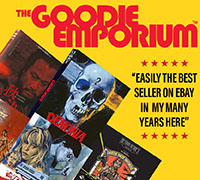Director: Ho Meng Hua
Cast: Yueh Hua, Ho Fan, Pang Pang, Tien Shun, Fan Mei Sheng, Kao Pao-Shu, Lan Wei-Lieh, Li Yin, Diana Chang Chung-Wen, Mao Wei
Running Time: 112 min.
By Paul Bramhall
Having gotten into Asian cinema in the late 1990’s, my first exposure to the phenomena of Journey to the West mania came in the 2010’s. For most of the decade it felt like a big screen adaptation of the 16th century novel was never more than a few months away – from Soi Cheang’s Monkey King trilogy (2014 – 2018), Stephen Chow’s double bill of Journey to the West: Conquering the Demons (2013) and Journey to the West: Demon Chapter (2017), Derek Kwok’s 2017 adaptation Wu Kong, to a big budget 3D animated feature in the form of The Monkey King: Uproar in Heaven (2012). That’s before you begin to count the literal bombardment of web-movies (easily pushing into double figures) that also took the tale as their inspiration.
Looking at the bigger picture though, it quickly becomes clear that movie adaptations of Journey to the West have never really gone away. Since the first known version in 1927 called Journey to the West: The Spider’s Cave, the tale of a monk travelling to India to retrieve a Buddhist scripture has been having the spotlight stolen out from under him for close to 100 yearsby one of his travelling companions, namely – Sun Wukong, the Monkey King. One of the most famous adaptations came in 1966, when the Shaw Brothers studio took up director Ho Meng-Hua (The Flying Guillotine, Shaolin Hand Lock) on his idea to bring the tale to the screen for the first time under the famous Shaw Brothers logo. Released in January (just 2 months after the Josephine Siao starring Monkey Saint Teases the Fairy of Flowers!), The Monkey Goes West proved to be a hit.
Released a year before Chang Cheh’s iconic One-Armed Swordsman, a production which shifted HK action cinema into a more violent and male orientated direction, The Monkey Goes West very much feels like a movie treading the border between the traditions of old, and the direction cinema was heading towards. This can be seen almost from the get-go with the top billing of Diana Chang, one of the most sought-after starlets of the 1950’s and 1960’s, for which The Monkey Goes West was one of her last roles before retiring from the film industry the following year. Despite having what essentially amounts to an extended cameo, the fact that pre-1960’s Hong Kong cinema was primarily dominated by female actresses (and their names carried the most star power) sees her name take the top spot. The real star of the show of course, as the title indicates, is the Monkey King himself.
The character proved to be one of two breakout roles in 1966 for Yueh Hua, with the other being cast in King Hu’s Come Drink with Me. Still a relative newcomer to the film industry, his dancing background saw him as a glorified extra in the likes of The Dancing Millionairess (1964) and The Lark (1965), but it was also this background which saw him chosen to play the sprightly Monkey King. The success of The Monkey Goes West would see a total of 3 sequels ushered into production, with one released later the same year (Princess Iron Fan), and the others being released in 1967 (The Cave of the Silken Web) and 1968 (The Land of Many Perfumes) respectively. However in a move that would act as a precursor to Donnie Yen’s decision after playing the same role in 2014’s The Monkey King, Hua would only return to the role for Princess Iron Fan, siting the makeup routine as being too much of a hassle to go through any further.
The other actors who make up the core foursome of any Journey to the West tale – the righteous monk, the gluttonous Pigsy, and the dependable Friar Sandy – were more game, and would maintain their roles throughout the sequels. The plot of The Monkey Goes West can basically be surmised as the origin story of how the 4 come to be together, with the monk meeting the others on his journey, and the various mishaps they encounter along the way, giving the narrative a road movie like feel. Ho Fan (Vermillion Door, Madam Slender Plum) plays the righteous monk, and somewhat ironically is most notable for transitioning into a director of Category III sleaze once he retired from acting in 1973 (including the 1991 classic Hidden Desire). Meanwhile Pang Pang (Killer Darts, The Water Margin) plays Pigsy, and Tien Shun (Tiger Boy, Too Late for Love) plays Friar Sandy.
The location shooting in Taiwan offers up some stunning scenery, which is mixed in with the Shaw Brothers lavish indoor sets, all of which are complimented by some charmingly old school special effects work. While rarely acknowledged for it, as a director Ho Meng-Hua helmed some of the Shaw Brothers more ambitious (or at least out there!) gene efforts that incorporated special effects in the 1970’s, with his name attributed to the likes of The Mighty Peking Man and Oily Maniac. Here we get everything from rear screen projection (the entire underwater finale is set against the backdrop of a fishtank), super imposition, some slightly clumsy wirework, and possibly the origin of the atrocious orange wigs from Spiritual Kung Fu. Sure it looks dated now, and some of the underwater costumes definitely have a “whoops, we’ve got 10 cents left, just get whatever you can” (yes, even for 1966) feel to them, but it all adds to the charm.
Other parts may possibly feel a little too quaint for modern audiences. At this point in Chinese cinema it was still considered quite normal for certain scenes to be sung in the Chinese Opera style, even if the production itself wasn’t considered to be a musical, such was the tradition so embedded in the cinematic output of the era. So we occasionally get conversation exchanges sung rather than spoken, although there admittedly is one musical number, the subject of which is how delicious the monk’s flesh is going to be. It sounds much more macabre on paper than how it comes across onscreen. In other scenes though it’s possible to see the modern style of filmmaking beginning to encroach. At one point the Green Snake Demon attempts to seduce Pang Pang by offering her 3 daughters for marriage, a scene which sees them disrobe to expose some shot from behind nudity, something that was unthinkable just a few years prior.
However it’s the brief bursts of action which offer the strongest indicator of how The Monkey Goes West had one foot in the future. While an action choreographer (criminally) isn’t credited, there’s a sprinkling of fight scenes that fall into the classic SB category of one versus many. The fluidity and speed of the action feels surprisingly ahead of its time, with Yueh Hua jumping and somersaulting around staff in hand fending off multiple opponents. In many ways the grounded nature of the choreography reminded me of Chang Cheh’s Journey to the West: Go West to Subdue Demons, which came 25 years later in 1991, and featured Tung Chi-Wa as the Monkey King (and I dare say features similar effects work to the 1966 outing!). Unlike Chang Cheh’s version though here the action is of a family friendly variety, which applies to the production as a whole (yes, even the brief sight of some bear butts won’t cause any offence for young eyes).
From a purely historical perspective, for fans of Hong Kong action cinema The Monkey Goes West also features the onscreen debut of a certain stuntman and member of the Jackie Chan Stuntman Association by the name of Mars, here just 11 years old and briefly turning up towards the end as a sand demon. However The Monkey Goes West serves as much more than just a historical snapshot of where Hong Kong cinema was at before it gradually became more modernised. Even almost 60 years on from its release it remains a genuinely enjoyable road movie that, by choosing to make its core focus the story of how the main foursome come together, proves that sometimes the simple approach is best. As a throwback to a time when big budget fantasy spectacles had to be made without any assistance from CGI, The Monkey Goes West is a refreshing journey to an era that we’ll never see again.
Paul Bramhall’s Rating: 7/10



